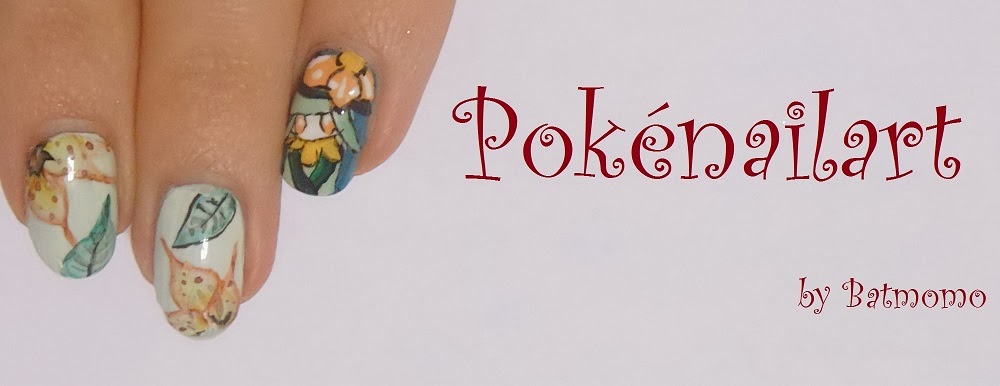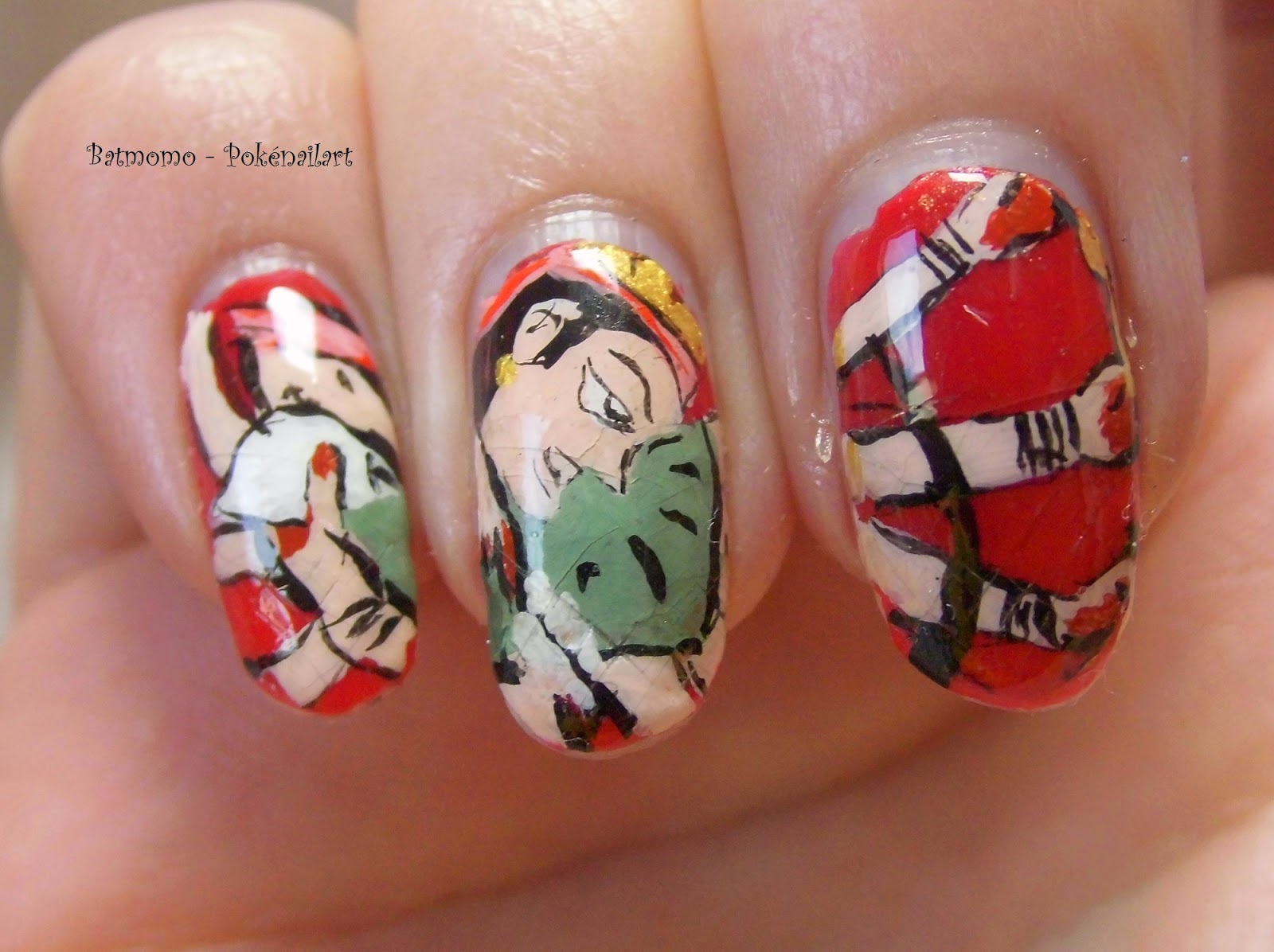Coucou tout le monde! Comme vous avez pu le voir avec mon nail art Holi, j'adore les films Bollywood. Mais ce que vous ne savez pas forcément, c'est que ce n'es pas la seule partie de la culture indienne que j'aime. Lorsque j'étais en licence, il fallait prendre une option qui n'était pas forcément en relation avec notre cursus principal. J'avais donc choisi Sanskrit, langue indienne ancienne. C'est incroyablement difficile, avec beaucoup plus de déclinaisons et de conjugaisons que le latin (en plus du singulier et du pluriel, il y a du duel, il y a aussi des modes verbaux qu'on n'a pas, comme l'aoriste... c'est vraiment compliqué XD) mais ça m'a surtout permis de découvrir les textes indiens, sa mythologie et ses épopées. C'est une culture extrêmement fascinante et aujourd'hui, je vous fait découvrir une déesse particulière (ma préférée je crois): Durga.
Hello everyone! As you could see with my Holi manicure, I love Bollywood films. But you may not know that it is not the only part of the Indian culture that I love. When I was an undergraduate student, I had to choose an optional module that didn't have to be related to my major, and I chose Sanskrit, an ancient Indian language. It is extremely difficult, and it has more declensions and conjugations than latin (and it does not just have a singular/plural system, they also have the dual form, and they have more verb aspects like aorist... it's really complicated XD) but it allowed me to discover amazing Indian texts, its mythology and its epic tales. It is a fascinating culture and today, I am introducing a particular goddess (who is my favourite I think): Durga.
ma reproduction:
my recreation:
Mais qui donc est cette Druga? Il y a différentes histoires narrant son apparition, la mythologie indienne étant très riches, chaque dieu a plusieurs histoires différentes, pas toujours compatibles. En ce qui concerne Druga, la version principale de son apparition est celle-ci: Le démon Mahishasura, de part son ascèse obtient un privilège des dieux: il ne pourra être tué par personne, à part une femme. Et il profite de son pouvoir pour vaincre les dieux et prendre leur place. Les dieux se réunissent donc pour trouver une solution à ce problème. Ils choisissent donc de créer une femme à partir des différentes parties du corps de chaque dieu, héritant ainsi du visage de Shiva, du visage de Yama, des bras de Vishnu etc. Chaque dieu lui donne son arme, Durga se retrouvant donc avec dix bras et une arme dans chaque main. Durga crée d'autres êtres pour fonder son armée, qui seront toutes des femmes, notamment Kali, déesse de la destruction. Durga ne se bat jamais avec des hommes (à ma connaissance, selon mes sources, mais il est difficile d'en être sûr vu la quantité de textes qu'il existe en Inde).
Vu qu'elle se bat sans aucune aide masculine, même pour l'organisation des batailles, Mahishasura croit à tort qu'il n'a rien à craindre de Durga, mais elle le vainc très facilement. La force et les plans de bataille de Durga la rende invaincue. Beaucoup souhaite l'épouser, mais elle n'acceptera de se marier qu'à un homme qui la vaincra sur un champ de bataille, ce qui est impossible et elle reste donc célibataire.
Elle vit également dans une zone reculée dans les montagnes Vindhya, accessibles seulement en faisant des efforts extraordinaires. Elle se nourrit de la chair et du sang de ceux qui la vénèrent (les personnes qui la vénèrent comme déesse principale font vraiment des offrandes de leur chair et leur sang). On dit d'elle qu'elle boit beaucoup de vin, même sur les champs de bataille (eh ouais, pas besoin de voir droit pour battre tout le monde, elle est trop forte).
Elle est donc à l'opposé de toutes les représentations traditionnelles de la femme indienne, souvent vue par rapport à quelqu'un (l'épouse de quelqu'un, la fille, soeur de quelqu'un...). Elle aide les dieux en battant Mahishasura, mais elle ne rend de comptes à personnes, elle est complètement indépendante. Mais elle a aussi un côté plus "doux", puisqu'elle protège également ceux qui la vénèrent lorsqu'ils ont besoin d'elles. Elle est donc reconnaissante.
Cet article est assez long comme ça alors je m'arrête là, mais si vous voulez en savoir plus, je vous conseille le livre " Hindu Goddesses: Visions of the Divine Feminine in the Hindu Religious Tradition" par David Kinsley dont j'ai tiré toutes mes informations.
http://mythologica.fr/hindou/durga.htm
Vu qu'elle se bat sans aucune aide masculine, même pour l'organisation des batailles, Mahishasura croit à tort qu'il n'a rien à craindre de Durga, mais elle le vainc très facilement. La force et les plans de bataille de Durga la rende invaincue. Beaucoup souhaite l'épouser, mais elle n'acceptera de se marier qu'à un homme qui la vaincra sur un champ de bataille, ce qui est impossible et elle reste donc célibataire.
Elle vit également dans une zone reculée dans les montagnes Vindhya, accessibles seulement en faisant des efforts extraordinaires. Elle se nourrit de la chair et du sang de ceux qui la vénèrent (les personnes qui la vénèrent comme déesse principale font vraiment des offrandes de leur chair et leur sang). On dit d'elle qu'elle boit beaucoup de vin, même sur les champs de bataille (eh ouais, pas besoin de voir droit pour battre tout le monde, elle est trop forte).
Elle est donc à l'opposé de toutes les représentations traditionnelles de la femme indienne, souvent vue par rapport à quelqu'un (l'épouse de quelqu'un, la fille, soeur de quelqu'un...). Elle aide les dieux en battant Mahishasura, mais elle ne rend de comptes à personnes, elle est complètement indépendante. Mais elle a aussi un côté plus "doux", puisqu'elle protège également ceux qui la vénèrent lorsqu'ils ont besoin d'elles. Elle est donc reconnaissante.
Cet article est assez long comme ça alors je m'arrête là, mais si vous voulez en savoir plus, je vous conseille le livre " Hindu Goddesses: Visions of the Divine Feminine in the Hindu Religious Tradition" par David Kinsley dont j'ai tiré toutes mes informations.
http://mythologica.fr/hindou/durga.htm
But who is Druga? There are several stories about her appearance, because the Indian mythology is extremely rich and dense, so each god has several stories that are not necessarily compatible. As for Druga, here is her "main" story: The demon Mahishasura, through asceticism, gets an incredible power from the gods: he will only be defeated by a woman. He takes advantage of this great power to fight against the gods and take their places. The gods meet in order to find a solution, and they create a goddess from the different body parts of each god: she gets the face of Shiva, the hair of Yama, and the arms of Vishnu for example. She also gets the weapon of each god, ending up with ten arms and a different weapon for each hand. Druga creates other female beings to complete her army, in particular Kali, the goddess of destruction. According to my sources, she never fights with any man.
Since she doesn't fight with any man, even for the planning of the battles, Mahishasura mistakenly assumes that she is weak and defenseless but she beats him fairly easily. Durga is so powerful and so good at organising her battles that she is never defeated. A lot of men want to marry her (yes, strong women can please men! XD) but she only accepts to marry a man who will defeat her in the battlefield, so she remains single.
She also lives in a remote place, in the Vindhya mountains, only accessible though heroic deeds. She feeds on the flesh and blood of her worshippers (and people who worship her as their main goddess really offer their blood and flesh to her). She also drinks a lot of wine, even when fighting (always winning a fight even though you can't see straight, that's quite an achievement).
Thus, she is the opposite of the traditional representation of the Indian woman, who is often seen as soft and also seen in relation to a man (like as the wife, sister or daughter of someone). Druga helps the gods by defeating Mahishasura, but that's it. She is completely independent for everything else, she decides what she does and for who. She also has a "softer" side because she often comes to the rescue of people who worship her. She is grateful.
This article is already quite long so I'm stopping here but if you want to know more, I would recommend the book "Hindu Goddesses: Visions of the Divine Feminine in the Hindu Religious Tradition" by David Kinsley from which I got most of the informations presented in this article.
Since she doesn't fight with any man, even for the planning of the battles, Mahishasura mistakenly assumes that she is weak and defenseless but she beats him fairly easily. Durga is so powerful and so good at organising her battles that she is never defeated. A lot of men want to marry her (yes, strong women can please men! XD) but she only accepts to marry a man who will defeat her in the battlefield, so she remains single.
She also lives in a remote place, in the Vindhya mountains, only accessible though heroic deeds. She feeds on the flesh and blood of her worshippers (and people who worship her as their main goddess really offer their blood and flesh to her). She also drinks a lot of wine, even when fighting (always winning a fight even though you can't see straight, that's quite an achievement).
Thus, she is the opposite of the traditional representation of the Indian woman, who is often seen as soft and also seen in relation to a man (like as the wife, sister or daughter of someone). Druga helps the gods by defeating Mahishasura, but that's it. She is completely independent for everything else, she decides what she does and for who. She also has a "softer" side because she often comes to the rescue of people who worship her. She is grateful.
This article is already quite long so I'm stopping here but if you want to know more, I would recommend the book "Hindu Goddesses: Visions of the Divine Feminine in the Hindu Religious Tradition" by David Kinsley from which I got most of the informations presented in this article.
J'espère ne pas trop vous avoir endormi et j'espère que ça vous a plu! à bientôt, bisous bisous
I hope that I didn't make you feel too sleepy and that you liked it! See you soon xoxo





Là je dois dire que j'aime autant ton nail art que la mythologie qui est super intéressante.
ReplyDeleteBisous Morgane.